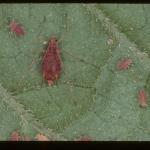Aphid, Potato
Macrosiphum euphorbiae
Green peach, melon or potato aphid may occur in potato, colonizing fields from mid June through July. Potato aphid is the largest of the three.
Identification:
Potato aphids are 3-4 mm long, with cornicles the same color as the body with dark tips. This type may be difficult to identify because their sexual forms produce both green and pink aphids. However, a good distinguishing characteristic is their speed; potato aphids move more quickly than other aphid species. These aphids complete 2-6 generations on their winter host of rose plants before moving on to their summer hosts, which include potato and tomato. Therefore, potato aphids are not typically seen in tunnels until later in the season but they have been reported as a growing problem among high tunnel tomato growers, so it’s a good idea to keep an eye out for them early on.
Crop Injury:
Plants of the rose family serve as alternate hosts to potato aphid in fall and spring. A wide range of weeds, field crops and vegetable crops are hosts in summer. In potato they feed first in young growing tips, spreading downward into older leaves. Injury includes leaf deformity and dieback.
Aphids spread viruses to seed and tablestock potatoes, which can reduce yields and quality. High populations of aphids can cause foliage to decline.
Monitoring & Thresholds:
Fields should be scouted for aphids starting in late June. Examine aphids/leaf on 50 fully grown compound leaves (5 leaves at ten locations in the field) from top, middle and bottom of the canopy. In fresh market and processing potato, the thresholds for insecticide application is when an average of five aphids per leaf are present, or 10 per leaf within two weeks of vine kill. In Maine, the economic threshold for tablestock and processing fields is when aphids are found on 50 percent of the plants or one winged aphid is found within the field.
Cultural Controls & Prevention:
Plant disease-free certified seed to avoid introducing viruses which could be spread by aphids.
Biological Controls:
In general, aphid predators are better at controlling high aphid populations, compared to parasitoids, as they are not as efficient at finding low numbers of aphids within the crop.
Lady beetles are effective at controlling high aphid populations but are highly dispersive and will leave the tunnel in search of food if aphid populations are too low. They can be effective if released under row cover in winter greens. Adults and larvae feed on a wide variety of aphid species.
Predatory midges (Aphidoletes aphidimyza) are another generalist aphid predator that can be purchased and released in your tunnel. They are active in summer months but when day lengths shortens to less than 15 hours (September-March), they enter diapause and become inactive. Larvae feed on aphids and adults feed on pollen and aphid honeydew. Banker plants used to support Aphidius colemani will also support Aphidoletes midges. The midges pupate in the soil, so place banker plants in a tray with moist sand to provide pupation sites if your tunnel has plastic mulch and weed mat.
Green lacewing larvae also feed on many aphid species. Adults feed on pollen and nectar. Lacewings can be purchased as eggs or larvae; larvae tend to survive better than eggs. Release far apart from each other, as larvae are cannibalistic. In summer months, if temperatures rise above 95°F, lacewings will move out of the tunnel. Lacewing activity and life cycle slows as temperature drops, but one report from Purdue University reported that adults remained active and laying eggs at 52°F.
Chemical Controls & Pesticides:
Use selective or systemic insecticides for Colorado potato beetle control in order to conserve natural enemies of aphids, which are abundant.
For current information on methods (including varieties, spacing, seeding, and fertility), weed, disease, and insect management, please visit the New England Vegetable Management Guide website.
Crops that are affected by this insect:
The Center for Agriculture, Food and the Environment and UMass Extension are equal opportunity providers and employers, United States Department of Agriculture cooperating. Contact your local Extension office for information on disability accommodations. Contact the State Center Director’s Office if you have concerns related to discrimination, 413-545-4800 or see ag.umass.edu/civil-rights-information.

